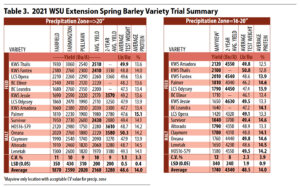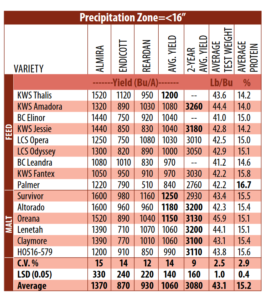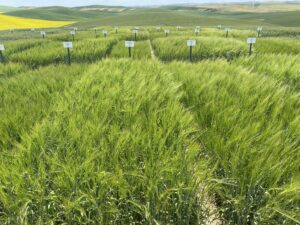By Clark Neely
Once again, Washington saw another dip in planted barley acres in 2021, down 7,000 acres from 2020 to only 83,000 acres according to the National Agricultural Statistics Service. The drought reduced average yield by an astounding 58 bushels to an average of only 38 bushels per acre. Indeed, the Washington State University (WSU) spring barley variety trials saw very similar trends in 2021. In fact, barley trials seemed to be impacted to a greater degree by the drought and scorching temperatures in June relative to the spring wheat trials. Average trial yields were down 43 to 84 percent, and test weights were down between 3.1 and 8.6 pounds per bushel.
The trials consisted of 14 
 named varieties and four experimental lines. Of the named varieties, eight were malt varieties, and six were feed varieties. While 12 spring barley variety trials were planted and harvested across three precipitation zones in 2021, data is only published for seven of them. Drought that produced very low yields exacerbated field variability and decreased reliability of the results. Only one of the four locations in the 12-to-16-inch precipitation zone produced any meaningful results. Yield, test weight and protein results from the remaining barley locations are summarized in Table 3.
named varieties and four experimental lines. Of the named varieties, eight were malt varieties, and six were feed varieties. While 12 spring barley variety trials were planted and harvested across three precipitation zones in 2021, data is only published for seven of them. Drought that produced very low yields exacerbated field variability and decreased reliability of the results. Only one of the four locations in the 12-to-16-inch precipitation zone produced any meaningful results. Yield, test weight and protein results from the remaining barley locations are summarized in Table 3.
Newcomers to the trial in 2021 included “KWS Thalis,” “BC Elinor” and “BC Leandra.” KWS is a global seed company based in Europe, and the “BC” entries come from a German breeding company, Breun, that is partnering with Limagrain Cereal Seeds. KWS Thalis was very competitive with the other entries in the trial under the drought conditions this year. In fact, it landed in the top group for yield in each precipitation zone and had exceptional test weight. BC Elinor and BC Leandra produced very similar yields to each other in each zone and were near the trial average. Both were near the bottom of the trial for test weight, though, except for BC Elinor in the more-than-20-inch precipitation zone.

“Survivor” had an uncharacteristically good year, landing in the top of the trial for yield in most cases when it normally is closer to the bottom. This is an earlier maturing, IMI-tolerant barley that can be used in wheat systems that utilize Beyond herbicide as it can tolerate residual in the soil. “KWS Fantex” and “Altorado” had relatively good years as well, placing in the top-yielding group in two out of three zones. “Oreana” stood out for maintaining excellent test weight under the adverse conditions.
Due to the exceptionally low yields this year, growers are encouraged to spend more time looking at multiyear data for a better representation of variety performance. Additional information and yield data can be found at smallgrains.wsu.edu. If you have any questions or concerns, feel free to contact me.
Acknowledgements: Funding for supplies, travel and technical support for the WSU Extension Cereal Variety Testing Program is provided by the Washington Grain Commission. Facilities, salary and equipment are provided by WSU administration. We are grateful for the many on-farm cooperators we partner with to conduct these trials around the state. They are essential for producing quality data and their donations of land, time and resources are appreciated.
This article originally appeared in the January 2022 issue of Wheat Life Magazine.

Clark Neely, Ph.D.
Clark Neely is the cereal variety testing lead and extension agronomist at Washington State University. His research interests include dryland cropping systems and advancing cereal variety testing. Read more about Dr. Neely.
